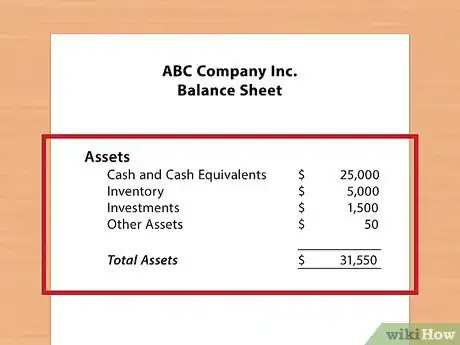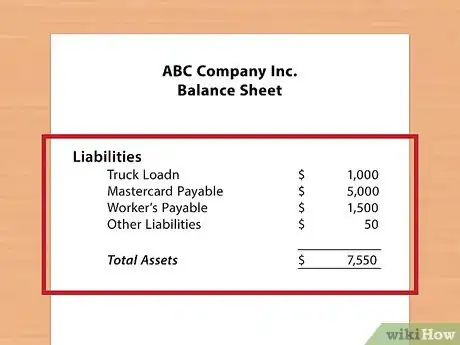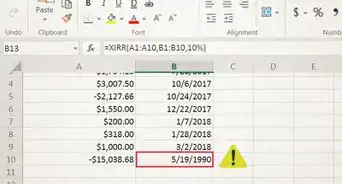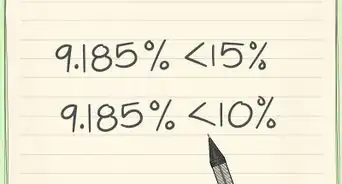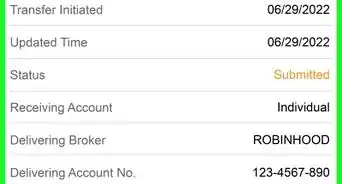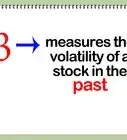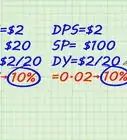This article was co-authored by Kathy Duong. Kathy Duong is a certified accountant who has been working as an accountant for over 25 years. She received her BS in Finance and Accounting from California State University, Los Angeles in 1992.
There are 7 references cited in this article, which can be found at the bottom of the page.
This article has been viewed 91,121 times.
The debt-to-asset ratio, also known simply as the debt ratio, describes how much of a company's assets are financed by borrowed money. Investors consider it, among other factors, to determine the strength of the business, and lenders may base loan interest rates on the ratio. Mathematically, it is a simple calculation, whether you are looking at your own company or researching potential investments.
Steps
Gathering Your Variables
-
1Locate a source of recent financial information for the company. In order to find the information that you need to calculate the asset to debt ratio, you will need financial information for the company in question. The best source of this information for any public company is the company's most recent balance sheet. This document should be produced by the company either annually or quarterly and clearly defines the required information.[1]
- This information may also be available on the company's annual report.
- Privately held companies are not required to disclose assets and debts to the public and any asset to debt ratio calculation will be based on your best researched estimates.
-
2Find the total assets of the company. An asset is defined as anything of value that could be sold or otherwise converted into cash. Total assets, the figure you need for this calculation, will be listed clearly on the company's balance sheet under a list of its parts (like current assets and fixed assets).[2]
- This figure will also include intangible assets, like patents and goodwill.[3]
Advertisement -
3Determine the total debt of the company. Find information about a company's debts on its balance sheet or in the annual report. The information that you need will be labeled as total liabilities or total debt. This represents the sum of the company's short-term and long-term liabilities.[4]
Calculating the Asset to Debt Ratio
-
1Set up your equation. After getting your total liabilities and total asset figures together, you will need to input these values into the equation. The formula for calculating the asset to debt ratio is simply: total liabilities / total assets.[5]
- For example, a company with total assets of $3 million and total liabilities of $1.8 million would find their asset to debt ratio by dividing $1,800,000/$3,000,000.
-
2Divide total liabilities by total assets. To solve the equation, simply divide total liabilities by total assets. For example above, this would give a result of 0.6. Because this calculation is often used a rough estimate of a company's debt levels, you can round decimal points off of your answer if it contains more decimal places.
-
3Convert your result to a percentage. It may be helpful to think of your answer in terms of a percentage. The result can then be read as, "the company has financed __ percent of its assets with debt." For example, the above example would say that the company has financed 60 percent of its assets with debt.
- Convert to a percentage by multiplying your result by 100. For example 0.6*100=60 percent.
-
4Consider subtracting intangible assets. When calculating this ratio, some may choose to subtract intangible assets from the total asset value. This is because it is unlikely that intangible assets were financed with debt (except in the case of a leveraged buyout of another company). Calculating the ratio without intangibles included can also be a better gauge of a company's actual ability to service its debt.[6]
- To calculate this, simply subtract the value of the intangibles from total assets and then divide as before.
-
5Calculate the debt to equity ratio. Another ratio, referred to as the debt to equity ratio, can be computed using this information. This ratio also provides a risk assessment for creditors of the company, and may be used in place of the asset to debt ratio. Calculate the debt to equity ratio by dividing total liabilities (from before) by total stockholder equity. Stockholder equity is equal to the difference between total assets and total liabilities (total assets - total liabilities) and represents the amount of the company's assets financed by investors.[7]
- For the example above, stockholder equity would be $3,000,000-$1,800,000, or $1,200,000. So, the debt to equity ratio would be $1,800,000/$1,200,000= 1.5.
- A higher ratio here represents more risk to lenders.
Using the Asset to Debt Ratio
-
1Understand what the ratio tells you. In general, the asset to debt ratio is a measure of a company's financial risk. That is, it measures how much of a company's debts could be paid off by selling its assets in case of liquidation. If it is less than 0.5, the company's ratio is strong, because the company is easily able to service their debts if they have to. If the ratio is large, like over 0.5 or especially over 1, more of the expenses are being paid by borrowed money, which might indicate less stability.[8]
-
2Analyze the company's solvency. Using the ratio obtained from this calculation, you can identify how leveraged a company is overall and compare that to other companies or industry averages. Acceptable asset to debt ratios vary by industry and growth stage, but an acceptable ratio is generally close to 0.5. This would mean that the company has only financed half of its assets with debt. In other words, they could pay their debts by selling off assets if they had to and still have half of their assets left over.
- Higher ratios may prevent the company from qualifying for further loans and may leave them unable to finance their operations if they run into financial trouble.[9]
-
3Analyze the asset to debt ratio of potential investments. If you are thinking of investing in a company, consider calculating its asset to debt ratio first. This will give you an idea of the risk of your investment. If the company is highly leveraged (with a high ratio), it is likely that they will be unable to survive an economic downturn. This means that you, as a potential bondholder, may not end up receiving the promise interest payments that come with the bond if you decide to purchase it.
- This also presents a risk for stockholders in the company, as a solvency crisis can drastically affect the price of the company's stock.
- A high debt ratio is particularly dangerous in cyclical industries (those industries which are worst affected by recessions), like the airline industry.[10]
-
4Know the weaknesses of the asset to debt ratio. Using the debt ratio alone will not tell you much about the actual level of risk present in a company. Many growing companies have high debt ratios but are managing their debt sustainably. For this reason, you should always evaluate companies comprehensively, using other types of analyses and ratios. To assess debt sustainability, look for indications that the company has paid off debt in the past, and if it did so quickly and efficiently.[11]
References
- ↑ http://www.myaccountingcourse.com/financial-ratios/debt-ratio
- ↑ http://www.bankrate.com/calculators/business/debt-ratio.aspx
- ↑ http://www.investopedia.com/terms/t/totaldebttototalassets.asp
- ↑ http://www.investopedia.com/terms/t/totaldebttototalassets.asp
- ↑ http://www.investorwords.com/5497/debt_asset_ratio.html
- ↑ http://www.accountingtools.com/debt-to-assets-ratio
- ↑ http://www.accountingcoach.com/blog/ebt-to-total-assets-ratio
- ↑ http://www.investopedia.com/terms/t/totaldebttototalassets.asp
- ↑ http://www.myaccountingcourse.com/financial-ratios/debt-ratio

